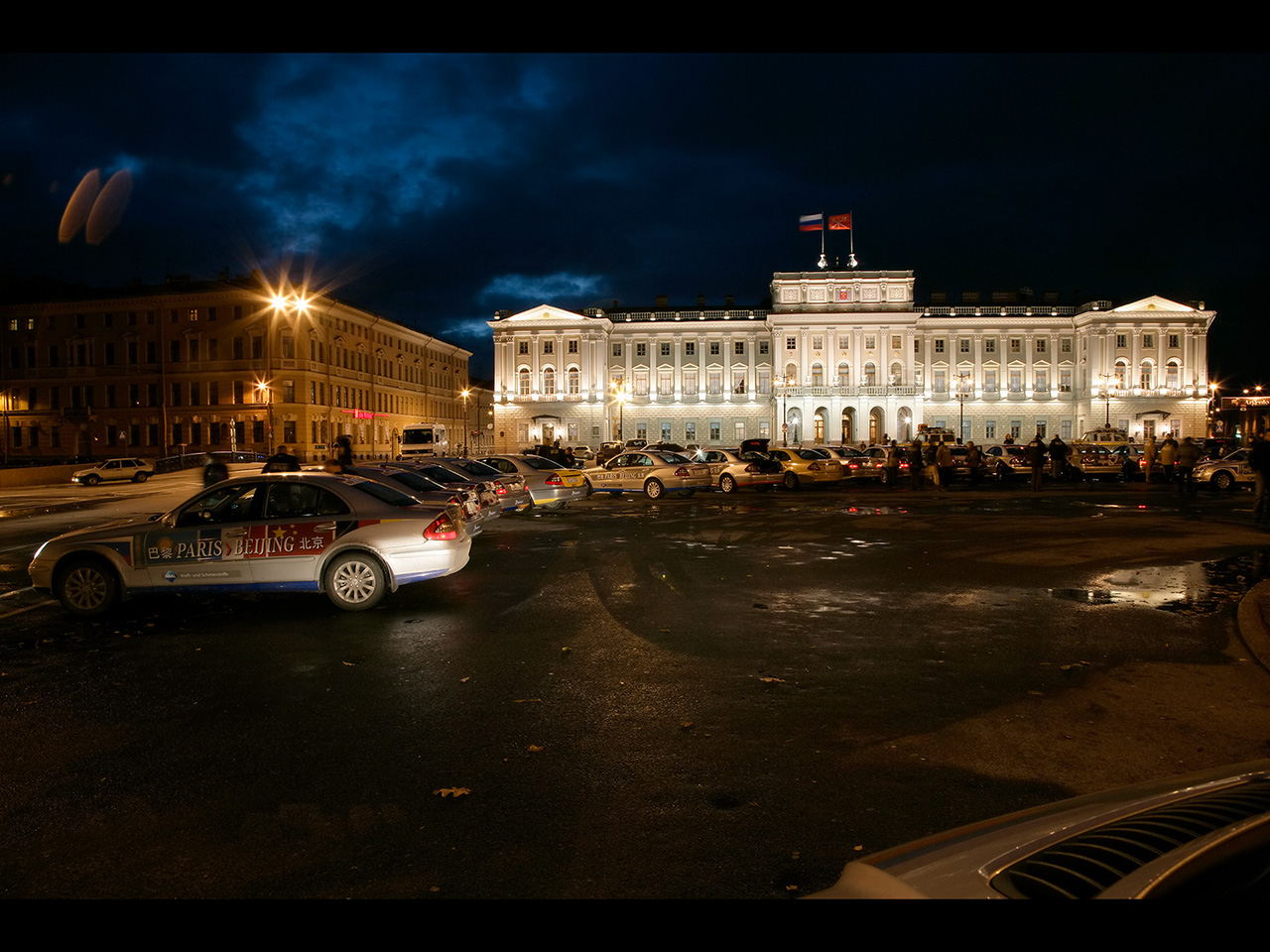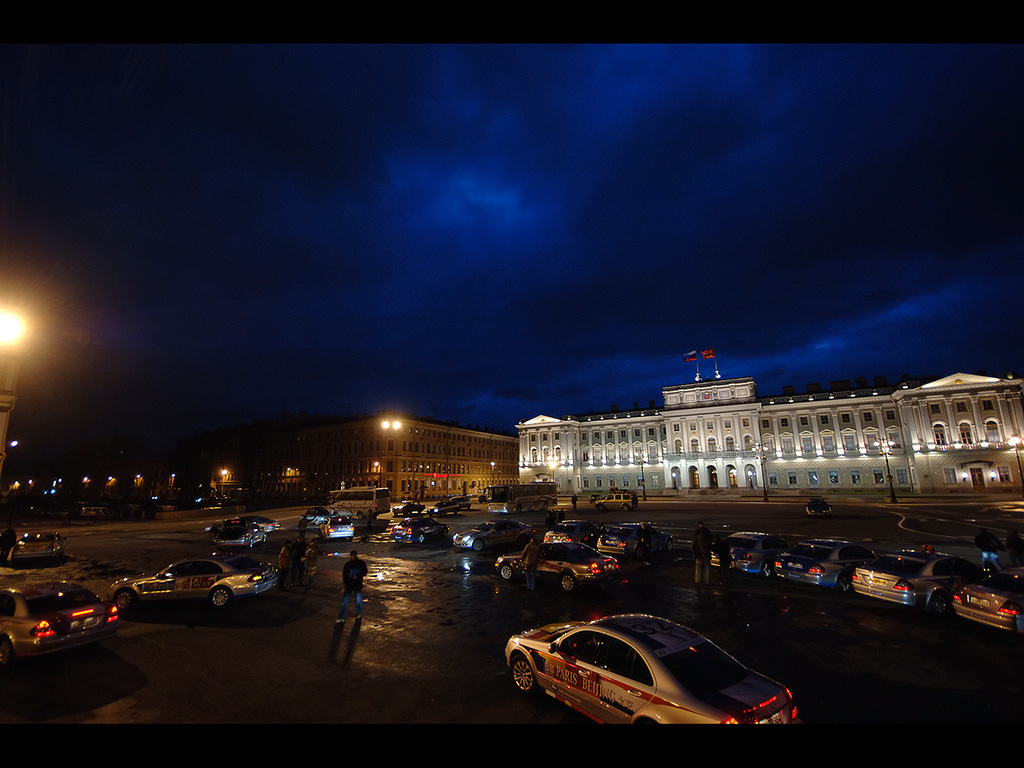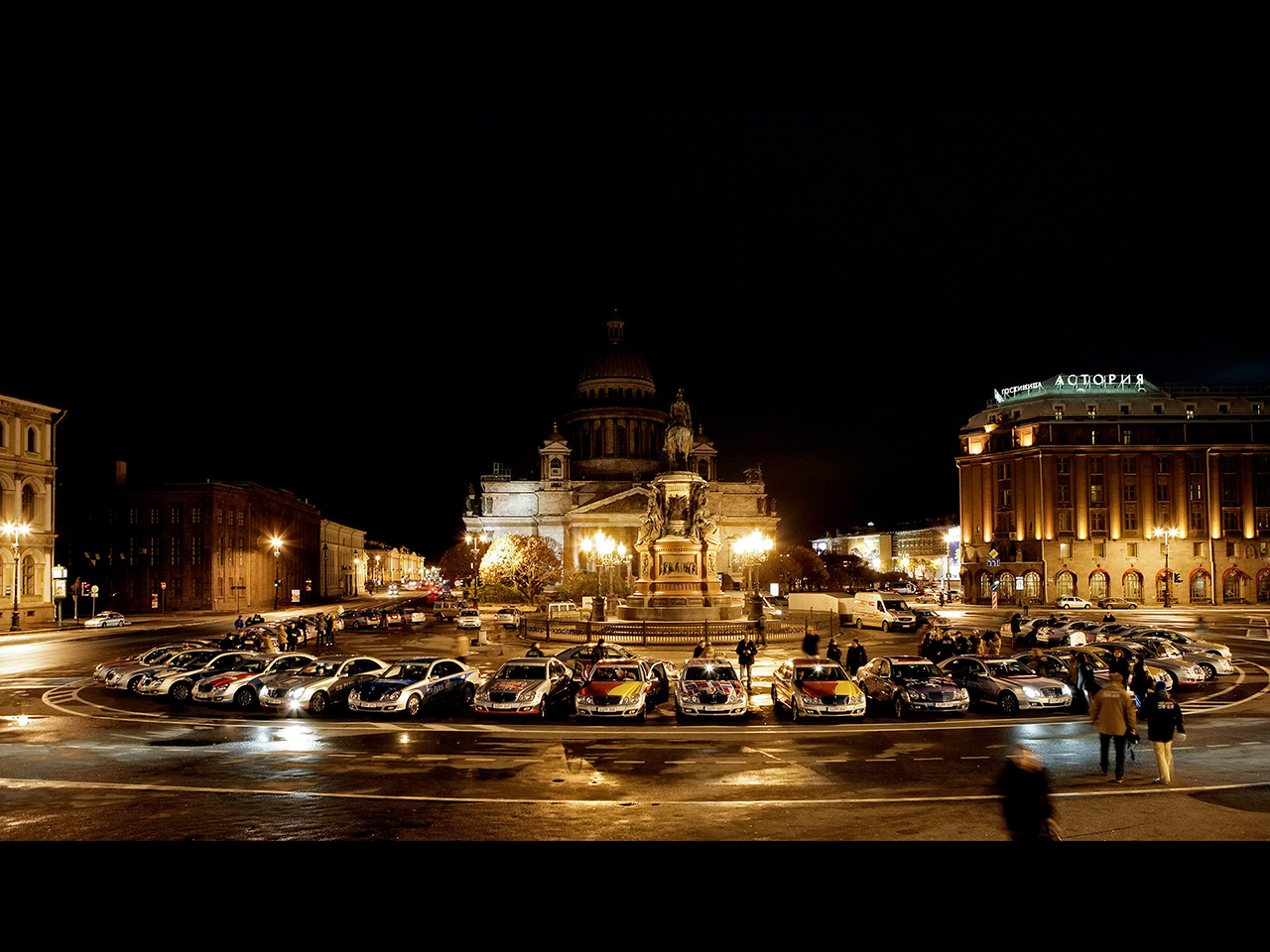2006 Mercedes-Benz E-Class Paris to Beijing 2
(from DaimlerChrysler Press Release) Long Distance Drive Paris–Beijing 2006 / Day 8: Stormy Start of Stage 2 (Second Leg)
Moscow – On the eighth day of the E-Class long distance drive the participants tackled the longest stretch thus far. As a kick-off to the second leg from St. Petersburg to Yekaterinburg the teams had to deal with a number of difficulties: the weather, the road conditions, and the traffic. The first accident of the tour was minor, leaving the drivers only slightly shaken.
On the previous evening, the teams of the first leg passed their car keys on to the next group of drivers in the magnificent rooms of the “Marble Palace“ with some regret. “I would have gladly driven on longer“ was a frequently heard comment. After the official start of the long distance drive on the Field of Mars (“Champs de Mars“) in Paris a week before, the first leg now ended in St. Petersburg, on another square bearing the name Field of Mars, (“Marsovo Pole”).
The local marble palace adorned with modern art works from the German Ludwig collection now houses a branch of the Russian Museum, and provided an impressive setting for the awards of the most economical drivers: The best team of the two Polish journalists, posted an average fuel consumption of only 6.8 litres per 100 kilometres between the French capital and the old Russian capital. The daily record achieved between Riga and Tallin was even lower, at 6.0 litres. The rest of the fleet likewise posted very good performance on that day: Although the E-Classes were heavily laden with up to three passengers and their luggage, and the first day’s route included a high share of motorways and expressways, the average consumption of the 36 E-Classes was only slightly over eight litres per 100 kilometres.
For the teams on the second leg – 80 participants from 23 countries – the first day of the longest stretch of the tour so far began in stormy weather with cool temperatures of around five degrees. The fleet started on the 700 kilometre drive to Moscow from St. Petersburg’s Isaacs Square at the crack of dawn. “The second leg will not be any less exciting and demanding than the first“, promised Johannes Reifenrath, Head of Global Communications of Mercedes Car Group, at the time of the key ceremony; a promise that was amply fulfilled not only by the constantly changing road conditions, but also by the mixture of rain, sleet and brilliant sun light that described the weather. The low autumn sun turned into a handicap: „I deliberately didn’t pack my sun glasses. I guess I hadn’t really considered that we’re always travelling eastward“, fussed Mike Collier from the UK Press Association. Nevertheless, he looked forward to the next stretch. The piercing light rewarded him with splashes of brilliant autumn colours. Another horizon, bizarre cloud formations, wonderful seascapes, close-set typically Russian wooden houses that often tilt from the wind and, just before Moscow; a breathtaking sunset turned the long drive into a unique experience. Not least because “it is a fine thing to be able to say that you travelled from St. Petersburg to Moscow in a single day – that is a really good conversation topic for any cocktail party.“
The heavy truck traffic and risky takeover manoeuvres by local drivers on the E95, the main connecting road between the old and new Russian capitals, posed a real challenge for the teams that day. This was also the site of the first accident of the tour, which was very slight and did not cause any personal damage: The two German journalists travelling with Car No. 12 had to break suddenly to make room for a cow that was crossing the main road. The Russian truck behind them unsuccessfully tried to avoid a collision, hitting the back of the car and severely damaging the rear right wing and rear lights as well as the buffer bar. The mechanics at Moscow’s Mercedes-Benz Branch are currently busy trying to repair the vehicle quickly, so that it can continue its drive to Beijing.
While the two drivers were getting over their light shock, their comrades had other needs to worry about: Rest stops with food and sanitation facilities according to Western standards are not to be found along the entire route. This made the drivers and their co-pilots all the more appreciative of the warm reception at Moscow’s Mercedes-Benz Center, where Jürgen Sauer, President of DaimlerChrysler Russia, and his team had organized an interesting party for the participants of the ”E-Class Experience“.
On behalf of the guests, Dr. Klaus Maier, Member of Mercedes Car Group responsible for sales and marketing said:”This company is a wonderful host. “ Mercedes-Benz and Russia are related by a long tradition. The first automobile was delivered here as early as 1894, just eight years after the discovery of the automobile. Due to the positive experience with the company, “Daimler Motoren Gesellschaft“ was appointed official supplier of the Tsar in 1912. The present-day distribution company DaimlerChrysler Automotive Russia, which originates from "Mercedes-Benz Avtomobili“, has been in existence since the year 2000.
Nizhni Novgorod – On the tenth day of this diesel marathon drive from Paris to Peking, the teams continued their journey through Russia’s seemingly endless expanses. Their route took them over the M7, known as the “Volga Highway,” although the road has little in common with the usual image of a freeway.
The Volga, at 3,534 km Europe’s longest river, is inextricably tied up with the Russian “soul.” “Mother Volga” is immortalized in innumerable poems and novels, and is a constant refrain in Russia’s melancholy songs. The river has always been a major trade route, and played an important part in Russia’s industrialization. As the birthplace of the Russian Orthodox church, it also has a special place in the country’s spiritual tradition. Lenin, too, was born beside the Volga, and ultimately returned to the banks of “his” river to die.
Contrary to some of the myths surrounding this part of the world, the drive over the Volga Highway on day 10 of the “E-Class Experience” turned out to be rather low-key: poor road surfaces, potholes, large numbers of trucks on the roads and police checkpoints at regular intervals all tested the patience of the participants. Despite the beginnings of a snowfall and sub-zero temperatures, the 36 E-Class cars completed the 400-kilometer day run to Kazan relatively quickly, in about six hours.
In spite of the cloudy winter weather, Pierre van Dahlen in car No. 2 was delighted with the view from the car windows, a typical Russian panorama of lakes and forests. “I’ve been fascinated with Russia since my school days, but never thought I would actually get to come here,” he said. Pierre, a South African and an avowed James Bond fan, is one of the six drivers to secure a place in the second stage, from over 50,000 applications on the Internet.
The drive through the
Chuvash Republic, past the capital of Cheboksary, was also a great
experience for spare-time rally driver Harald von Langsdorff. Harald,
born in Baden-Baden, but a resident of Canada for the last 15 years,
proved to be the perfect ambassador for his chosen sport. Giveaways
such as baseball caps, ballpoint pens and keyrings helped to thaw
out the locals during their brief stops, in spite of the freezing
temperatures. “In car rallies, people always hand out posters and
similar giveaways, as a way of leaving you with a good impression.
So even though this isn’t a race, I decided to follow the
tradition.”
Chuvashia is one of the most densely populated republics in the
Russian Federation. The capital, with a population of 442,000, is
Cheboksary, located by a reservoir of the same name formed by a
hydroelectric dam on the Volga. The artificial lake extends over
around 100 kilometers of the river’s course. Some 150 kilometers
further east, another such reservoir, the lake formed by the Samara
dam (Europe’s largest reservoir, with a length of around 550
kilometers) is a sign that the day’s destination of Kazan is not too
far away. Kazan is the capital of the republic of Tatarstan, and the
center of one of the country’s economically most highly developed
areas. Its importance is based primarily on petroleum and natural
gas production. The prosperous city of around 1.1 million
inhabitants presents a stunning juxtaposition of East and West. The
magnificent Cathedral of the Annunciation and the neighboring Qul
Sharif mosque symbolize the harmonious coexistence of the republic’s
Muslim and Orthodox communities. The city’s Kremlin, where the teams
park their E-Classes on arrival, is considered one of Russia’s
finest.
After a tour of the mighty fortress, it was time to sample the
delights of a Tatar restaurant. The meal began with pickled
gherkins, a well-known local specialty, and the waiters’ appearance
with the fish and meat dishes, served with style under heavy silver
platter covers in the manner of a top-class restaurant, drew
spontaneous applause from the international visitors.
This excellent standard of service was no accident, given
Tatarstan’s commitment to building up a quality tourism sector as a
major source of income. For example, last year the Shalyapin Palace
Hotel, where the teams stayed the night, won an incentive award for
tourism in Tatarstan in the twenty-first century, and also a
heritage prize for the exemplary reconstruction of its historic
rooms. This followed some decades of greeting rather less demanding
guests under the name “Hotel Soviet.”
Perm – On Day 11 of the E-Class Experience, the 36 teams were caught unawares by heavy snow, requiring the drivers to use all their skills. Thirteen hours had elapsed by the time the teams at the rear of the field had managed to negotiate the slippery surfaces and difficult roads to complete the stage successfully.
There was no sign of the challenges that lay ahead as the cars set off from in front of the Kazan Kremlin. The weather was overcast, but not unpleasant. Highway No. 7 heading towards Perm was looking its scenic best. The teams completed the first few kilometres with ease, using their mobile phones to exchange jokes or point out the best roadside views. The picturesque countryside outside Kazan, with the typical Russian wooden houses and groves of birch trees, gradually gave way to the wide open spaces and much larger forests characteristic of the landscape of Tatarstan.
“It’s pretty much like
our landscape at home,” said Lithuanian Tomas Kuprys, one of the
event participants from AutoBild. As a national of a former Soviet
state, the route to the east had a special fascination for him.
“It's great to be able to get an idea of how my parents lived in the
old days. The Baltic states have developed a lot since then, but
here nothing much has changed.” About 250 kilometres after their
starting point in Kazan, the intrepid travelers left Tatarstan and
entered Udmurtia, a republic in the Russian Federation that is well
known for its rich and diverse flora and fauna, as well as large
deposits of oil and coal.
But only another 100 kilometres later, the teams had to forget about
the beauty of the scenery, as heavy snow brought about an abrupt
change in the road conditions. The Michelin Pilot Alpin “MO” winter
tires (for “Mercedes-Benz Original”) were now put through their
paces. They certainly passed the test, because while for the E-Class
drivers the only effect of the rapid transition to a world of snow
was to reinforce the feeling of an authentic Russian experience, the
increasingly slippery surface had many of the Russian motorists,
with less suitable tires on their wheels, skidding out of control.
So now all the drivers had to concentrate on the job in hand. The
time zone changes about 200 kilometres before Perm, so twilight fell
early, making the conditions even more difficult. “Just as well we
are driving such a safe and responsive car,” commented a relieved
Tomas Kuprys, after successfully maneuvering his way around some
potentially hazardous obstacles. Pradeep Paul, journalist of „The
Strait Times“ from Singapore, had only ever seen snow on television,
and he was happy to reach the destination after driving for 300
kilometres on this freshly fallen snow. “That was a really tough
stage,” was all he had to say. He and his co-driver from Malaysia
had completed the run in around 10.5 hours, but that was nothing to
complain about, since 13 hours had elapsed before the stragglers at
the rear made it to their destination: the city of Perm, formerly
Molotov.
In fact, the arrival in the Urals was something of a homecoming, since the name of DaimlerChrysler is already known and appreciated in the city in the Urals. In October 2004, DaimlerChrysIer Automotive Russia opened a training center in Perm, as a joint project with the German Development and Skills Working Group (AGEF), the investment and development company Deutsche Investitions- und Entwicklungsgesellschaft mbH (DEG), the Center for International Migration and Development (CIM), and Perm State University. The training center introduces local students to leading-edge western technology, as a gateway to their participation in global economic progress.
More heavy snow was forecast for the next day, and, as a safety precaution, the departure time for the second long stage on the route from St. Petersburg to Yekaterinburg was brought forward by one hour.
Yekaterinburg – Today, twelve days and roughly 6,200 kilometres from the start in Paris, the E-Class long-distance fleet finally reached Asia. In the afternoon, after the crossing of the Urals, blanketed in deep winter snow, the fleet of 36 E-Class diesel vehicles crossed the imaginary dividing line between Europe and Asia. The Russian author Andrey Kurkov, who is taking part in the second stage of the E-Class Experience, seized the opportunity to cross from Europe to Asia on foot.
In view of the wintry conditions, the tour management had brought forward the day’s start by an hour, and also arranged an extra briefing early in the morning to give participants detailed, practical instructions on how to use the snow chains. The Russian author Andrey Kurkov was one of those listening carefully to the instructions from the professionals. The international bestselling writer and scriptwriter is one of the international guests on the second stage of the E-Class Experience. Kurkov, who was born in 1961, spent his childhood in Kiev, and today divides his time between his home city and London, where he is a member of the PEN Club. His novels, the best known of which are Petrovich and Death and the Penguin, take an ironic look at life in post-Soviet society.
At the morning start from Perm, it was clear to everyone that an economic recovery is well underway in this city, which is home to Russia’s largest oil corporation. There are many private homes made of stone, as well as the traditional Russian wooden structures. “Journalists have told me that conditions here have improved dramatically over the last three years,” explained Andrey Kurkov, who speaks seven different languages. The average income has risen from roughly 200 dollars to 400 dollars, he adds. “And you can live here quite well on 300 dollars.”
Unlike the previous day, visibility today was excellent. Despite the deep blanket of snow on the roads, the teams generally made smooth progress, with no major delays. The E-Class vehicles headed for the Ural Mountains through the snowy landscape. This impressive mountain range extends for 2,500 kilometres through the western central part of Russia. Together with the Ural River, the mountains form the imaginary border between Europe and Asia. The big countdown started with 232 kilometres to go: “Only nine kilometers to Asia, only three, only one” – and, under the shadow of the enormous white border monument, a delighted Andrey Kurkov (for the first time in his life) walked from one continent to the next.
After the dividing line, the tour continued through Eurasia in excellent conditions, at times in glorious sunshine – heading down from the mountain terrain of the Urals and on to the vast western Siberian plain, which extends eastwards, covering approximately 2.5 million square kilometres as far as the Central Siberian Highlands. After 494 kilometres of a Russian winter’s fairy tale, they finally arrived at the final destination for the day: Yekaterinburg, a major transport hub and the country’s fourth-largest city, with just on 1.3 million inhabitants. Previously known as Sverdlovsk, it attained tragic notoriety as the place where the last Russian Czar, Nicholas II, and his family were murdered in 1918. A cathedral now stands on the site of the murders, and is today one of Yekaterinburg’s most visited tourist attractions. Kurkov informs us that a further attraction in the former Sverdlovsk is the television tower. Its construction was begun in the late 1980s, but was never completed because funding ran out. Work was therefore stopped at a height of 220 metres. The planned height was over 400 metres.
Yekaterinburg is the final stop on the second of the five stages between Paris and Peking. Tomorrow, the participants in the E-Class Experience will say goodbye and hand over the car keys of “their” E-Class vehicles to the next teams, most of whom have already arrived today by plane.



